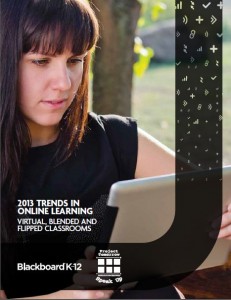 The 2013 Trends in Online Learning – Virtual, Blended and Flipped Classrooms (USA) report outlines the effectiveness and impact of technology in a variety of learning modes and provides an insight into future applications of technology enabling student learning and engagement. Key findings include:
The 2013 Trends in Online Learning – Virtual, Blended and Flipped Classrooms (USA) report outlines the effectiveness and impact of technology in a variety of learning modes and provides an insight into future applications of technology enabling student learning and engagement. Key findings include:
- Administrators are widening their scope regarding the value of online classes to include learning opportunities for administrators, teachers and other support staff in addition to students.
- Virtual, blended and flipped learning teachers are using more digital content with their students than other teachers.
- Online learning teachers see significant value in the role of digital tools and resources to improve student success as well as their own personal productivity.
- Parents who have taken an online class for their own work or job training have high expectations for their child’s school to provide similar learning opportunities.
- Students are increasingly seeing online learning as a gateway to a new education paradigm where they are in control of the learning process.
What’s happening in Victoria?
Flipped Learning
- The 2013 Trends in Online Learning describes flipped learning as students watch videos of lectures or read content as homework, and class time is spent on project-based learning and personalised remediation.
‘The sign of a great student centred activity is that all students are actively discussing the concept in their own words – Verso definitely hit the mark here. As a teacher being able to see each student’s original post and comments also offers a visibility of their learning – you can almost watch it happen!’ Steve Seddon
- Steve Seddon from Noble Park Secondary College has been using online video to engage students as well as make more effective use of classroom and homework time. He has recently trialled Verso – a web based app that creates opportunity for student collaboration and discussion around a stimulus question, video, images, files or websites. Read Steve’s blog post for more information.
- Find resources for flipped learning in this FUSE package.
Virtual Learning
- Virtual learning allows students to connect, interact, share and learn with others outside of their classroom and school using virtual conferencing tools such as Polycom, Blackboard Collaborate, Microsoft Lync and Skype. Virtual learning can be synchronous where all students log in at the one time in a virtual classroom, or it may be asynchronous and involve students accessing recordings of a session to access in their own time.
- Find out more – Virtual conferencing, Connecting to learn – for students and teachers and the Vic Virtual Learning Project.
Blended Learning
- Blended learning is where instruction is a mix of online and face-to-face with a teacher. In the Victorian context this refers to the planned implementation of a learning model that integrates student-centred, traditional in-class learning with other flexible learning methodologies using mobile and web-based online (especially collaborative) approaches in order to realise strategic advantages for the education system. From Blended learning, A synthesis of research findings in Victorian education 2006-2011
- Other blended learning resources showing how it can be incorporated into the classroom include: Blended learning in languages education and Contemporary (Digital) Literacy Practices of Preps.


Pingback: Virtual, blended and flipped classrooms | Digit...
Pingback: Virtual, blended and flipped classrooms | global2